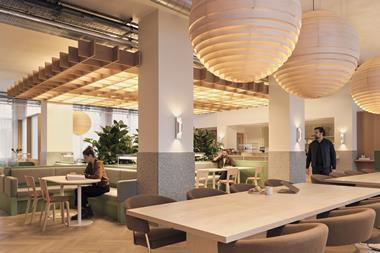Office developments should be multifaceted and deliver purpose and meaning for local communities.

To attract and retain tenants in the current workplace market, offices need to be fit for purpose not only from an operational and environmental perspective, but also a cultural perspective. This does not just mean company culture, but the collective customs, ideas and behaviours of city and society.
Commercial workspace schemes need to be considered as multifaceted products and must deliver purpose and meaning for their local communities. This is not just about mixed-use, but also purposefully establishing cultural and civic connection with a host of inclusive amenities.
Traditionally, this has involved the delivery of new public realm, but it should also consider commercial placemaking elements such as restaurants, shops, nurseries and gyms. Spaces should also be considered for cultural events or public art, creating bridges between the macrocosm of the workspace and the local community.
Not only can these elements add integrity and long-term value to a site, but when carefully designed and curated, they add vitality and cultural interest, reframing the traditional office product as an aspirational destination space.
One can look at the success of pioneers such as First Street in Manchester, with its innovative blend of culture, leisure, retail and grade-A commercial office space; or Broadgate in the City of London, with its exciting mix of business, leisure and public realm, and where a recent initiative between British Land and New Diorama Theatre to provide arts project spaces confirmed its place in the cultural milieu of the city.
Enhanced civic realm
103 Colmore Row (pictured), a 26-storey scheme we recently designed and delivered in Birmingham for Sterling Property Ventures and Tristan Capital Partners, was conceived first and foremost to enhance the civic realm, not only providing versatile, high-quality workspace, but also giving public space to the city. Public art, gallery space, a café and a restaurant are essential elements of the product.
Andy Street, mayor of the West Midlands, said it symbolised enormous ambition and “hope for our region”. The association with ambition and confidence that the physicality of the building’s form exudes, together with the building’s cultural spaces, has been fundamental to attracting occupiers to this speculative development.
The strength of the product is obvious: the scheme is projected to be fully let by the end of the year, with businesses choosing 103 Colmore Row not only to improve their profile but to be part of the building’s story.
Looking further ahead to schemes such as New City Place in central Milton Keynes, Sterling Property Ventures will develop the product further and create a dynamic new focal point for civic life. The proposals developed so far are illustrative of the cultural potential for city-centre business districts and their ability to attract tenants.
Critically, the landmark buildings at New City Place are not the centre of attention here – it is the ambition to maximise the public realm that will invigorate this piece of the city to create a special and enduring place.
The public squares and street are the central elements of the composition, and the buildings seamlessly merge with them – a factor now possible as the boundaries between public, commercial and private uses continue to hybridise and form complementary bonds.
Redesigning our workspaces as cultural hubs embedded in our civic society points a way forward to bringing people back together, encouraging personal development and optimising business success.
Ross Kerr is director at Ryder Architecture






























1 Readers' comment